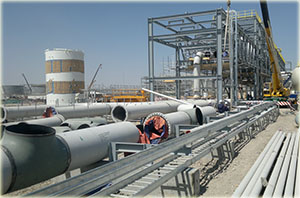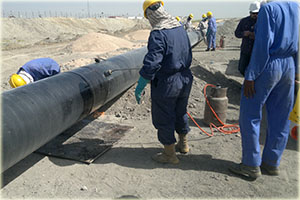|
Oil Field Development
Our experience in the oil field development will cover the following services: CPF & WELL PAD CONSTRUCYION
Speed of Pipeline Construction
• Pipe line layout : Has the basic concepts on experience in this field by offering a fleet of machineries& equipment with high skilled manpower . • Route selection : Our experience show that route selection is the first and most effective means of preventing pipeline impacts from the 3 environmental assessments of pipelines are neither new, nor precedent setting. The environmental assessment of pipeline impacts on vulnerable ethnic minorities, biodiversity, conservation units, and spill risks is standard practice in other projects by now. Of course each pipelines is different, but the methodologies and the types of impacts to be aware of have long since become standard. As route selection most important means of reducing environmental social impacts, it needs to be the centerpiece of the ESA. Route selection is normally expected in the "Analysis of alternatives. Starting from one fixed point- the oil or gas reserve – there is major scope for directional drilling. For example, if a hydrocarbon reserve is located inside a "sensitive area" (e.g., indigenous peoples, a densely populated town, rich biodiversity, old growth forest, directional can avoid damage to these native area by drilling laterally as far as possible. Directional drilling technology is improving annually and needs to be fully exploited before contemplating any sensitive area. • Access roads: The impacts from construction of access roads can and often dose the impacts of the pipelines right of –way (ROW). Routing the pipeline to minimize the length of access roads can be effective. Formal agreements to deactivate access roads and bridges immediately following construction helps reduce impacts greatly. Ensuring that the ROW cannot be used for transport or unplanned settlement, also prevents major. Monitoring and maintenance nowadays is increasingly feasible by helicopter, which greatly reduces the impacts of the project. Traffic accidents sustain ability demands zero loss of life or serious injuries. Planning for vehicular traffic is the first step. Well- know accident reduction need to be emphasized. Proponent safety (seat belts, hard hats, visible clothing boots and signal) already is effective in better run project. Buried Vs. above- ground pipelines were built above ground even when on harsh terrain such as permafrost muskeg. Associated brines may not been stripped off leading to rapid corrosion of the steel piping, many Siberian of oil pipelines are old leak but not enough to warrant repair. Modern pipelines are buried, welds thoroughly inspected beforehand. Inner and cuter pipeline coatings are increasingly in improving protection and longevity of the steel pipe. Corrosion of steel is prevented by removal of water and salts. Catholic is becoming standard. Fiber – optics detect eve n minor very early leak or rupture. Trenching for buried pipelines is a dear impact but burial restoration helps land use to revert to normal, reducing long- term impacts, and the risk of sabotage, ruptures from traffic crashes or even drunken. Above- ground pipelines can impede passage of humans sheep flocks vehicles and wildlife and removes the often 50m-wide ROW from other land- use The impact of traffic the impact of converting a quiet country lane into a major highway with 50 heavy trucks a day is severe. Pipeline construction traffic magnified into hundreds of heavy trucks every day. One of the most frequent complaints was that the rumbling trucks caused cracks in the old dwellings usually sited adjacent to the road. Such dwellings were made of wattle- and –daub, log-and mud, mud bricks or low quality fired bricks so such cracking is expected. In this case best practice is to upgrade the dirt road into a sealed blacktop highway of the same width to avoid any resettlement. For the proponent to send in teams of lawyers to dispute the causes of the cracks engenders ill- will and is regressive. |
| Prepare the Printer Back to Previous |
 Are you looking to enter to or expand into the natural gas & oil field CPF/ Wells market if so, can help. We have experience in the fields and services, engineering and site contracting services, crushed stone quarries and concrete in the asphalt batch plant, Steel Structure fireproofing, AG/UG Piping. Our services focus on safety for your site, primarily and we will provide the latest technology and services to ensure there are on leaks or accidents associated with your job site. Since ventures is a company dedicated to preserving the environment, as well as careful use of natural resources, we will make a perfect partnership when it comes to constructing your natural gas or oil well pad. Provides a full line of engineering, materials and construction services when we undertake your project. Our theme is design to done all you have left to do is drill! Engineering includes
Are you looking to enter to or expand into the natural gas & oil field CPF/ Wells market if so, can help. We have experience in the fields and services, engineering and site contracting services, crushed stone quarries and concrete in the asphalt batch plant, Steel Structure fireproofing, AG/UG Piping. Our services focus on safety for your site, primarily and we will provide the latest technology and services to ensure there are on leaks or accidents associated with your job site. Since ventures is a company dedicated to preserving the environment, as well as careful use of natural resources, we will make a perfect partnership when it comes to constructing your natural gas or oil well pad. Provides a full line of engineering, materials and construction services when we undertake your project. Our theme is design to done all you have left to do is drill! Engineering includes The speed at which pipeline are built is one of the more serious constraints in preventing impacts. Most bog infrastructure takes many years to plan and build. Completion of pipelines on the other hand often takes 24 to 36 months. This means it is even more important for the ESA of pipelines to begin as soon as the pre feasibility planning begins. Route selection, the main means of reducing impacts is often one of the first items planning by the engineers, we offer these to help services both turn –key-from design to done and individually, so whatever your level of need we are here to help you gat drilling, quickly and painlessly. We would be glad to discuss any natural Gas and crude well pad and X –MAS tree construction opportunities with you.
The speed at which pipeline are built is one of the more serious constraints in preventing impacts. Most bog infrastructure takes many years to plan and build. Completion of pipelines on the other hand often takes 24 to 36 months. This means it is even more important for the ESA of pipelines to begin as soon as the pre feasibility planning begins. Route selection, the main means of reducing impacts is often one of the first items planning by the engineers, we offer these to help services both turn –key-from design to done and individually, so whatever your level of need we are here to help you gat drilling, quickly and painlessly. We would be glad to discuss any natural Gas and crude well pad and X –MAS tree construction opportunities with you.